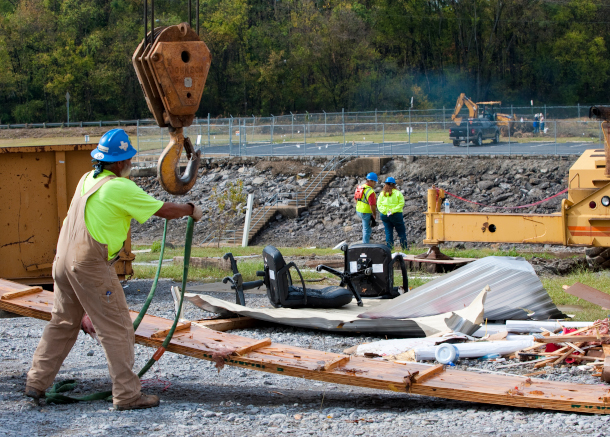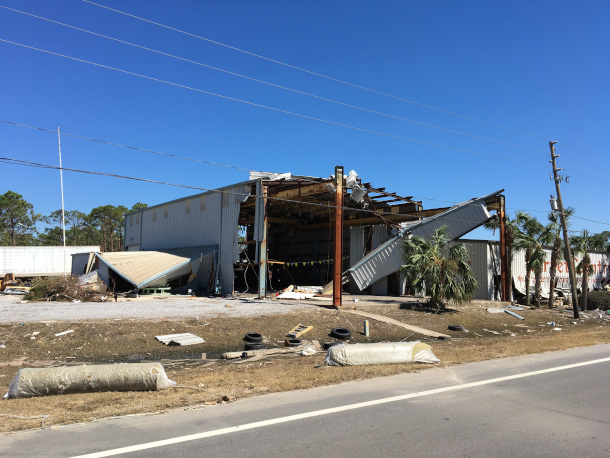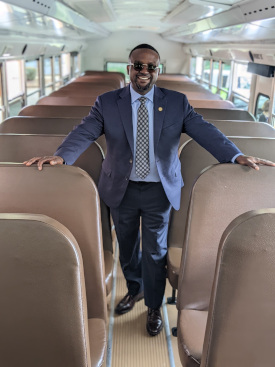Environmental Justice for All of Government
Air Date: Week of June 2, 2023

The EPA enlists aid from other governmental agencies such as Health and Human Services and FEMA to respond to severe weather events. (Photo: Chickamauga Tornado, Flickr, CC BY-SA 2.0)
President Biden recently created a White House Office of Environmental Justice to coordinate EJ efforts across all federal agencies. EPA Region 4 Administrator Daniel Blackman joins Host Steve Curwood to discuss how the office can help address the disproportionate pollution and climate-related damages that environmental justice communities in the Southeast U.S. often suffer.
Transcript
CURWOOD: During his first week as President, Joe Biden sought to meet his campaign pledge to address the disproportionate impacts of climate disruption and pollution on disadvantaged communities by creating the White House Environmental Justice Advisory Council. But soon it was obvious mere advice would not be enough, so then he established a White House Office of Environmental Justice to impose accountability and reporting requirements across the government. The White House has yet to name a federal Chief Environmental Justice Officer to head this EJ enforcement operation, but there are already some environmental justice cops on the beat, including Daniel Blackman, administrator for EPA’s Region 4. His region stretches from Mississippi to Kentucky to North Carolina and Florida, with numerous disadvantaged communities plagued by industrial and livestock waste pollution and climate-related hurricanes and tornadoes. And he joins me now from Atlanta. Welcome to Living on Earth, Administrator Blackman.
BLACKMAN: Happy to be a part of this conversation.
CURWOOD: So, President Biden has formed the White House Office of Environmental Justice and called for EJ to be looked at for all of government. What does that mean for Region 4 of the EPA?
BLACKMAN: It's really a great opportunity in this administration to prioritize the commitment and the focus the President has, by making sure that these agencies, including EPA, are not working in silos. As it relates to Region 4, we have a longstanding relationship with how we work with what's called interagency collaboration, when storms or major weather events happen. We are very capable of working with our federal family, that's, you know, Health and Human Services, FEMA, HUD, Department of Energy, you know, we all play a critical role. And the President's commitment is to make sure that we are not only efficient in our communication, but that we are working tirelessly to ensure that these organizations and these groups are on the same page. And I'll give you one really quick way of how that works for us. And that's in Selma, Alabama, the President had a chance to speak in Selma. And within 72 hours, he deployed each of the federal agencies to respond to how we're going to have an impact right here in Region 4 with Selma, Alabama, as it relates to recovery from an economic standpoint. We had already had people on the ground dealing with storm recovery from a recent tornado. And we immediately jumped into action with our federal family, led by Mitch Landrieu, who's a senior adviser to the President, on how we would communicate, and it's been a great opportunity to see it all work in motion.
CURWOOD: So, give me the broad picture for a moment here. I mean, overall, what changes throughout government do you hope, expect, to see from the establishment of the White House Environmental Justice Office? What's the big picture here?

The Category 4 Hurricane Michael devastated the city of Port St. Joe and many other Florida communities in 2018. (Photo: Florida Fish and Wildlife, Flickr, CC BY-NC-ND 2.0)
BLACKMAN: The big picture is to make sure that we, number one, are not checking the box. And I can't stress enough how much Administrator Regan from day one has been on the ground with each and every one of the regional administrators from around the United States. And that started off with the Journey to Justice, we were very adamant about making sure that we went into communities in Region 4 like Jackson, Mississippi, we wanted to make sure that we considered areas like Lowndes County, Alabama, and areas that touch Region 6, Region 5, and other areas, because we wanted to take a proactive approach to not, again, checking the box, right? Because it's easy to say we showed up at a meeting, it's easy to say that we gave a grant. But what we recognize is that when you're working with federal agencies and communities have suffered from what we categorize as meeting fatigue, right, administration to administration, decade to decade, these communities have just wanted somebody to show up and follow through. And that's really what this opportunity does. It doesn't allow EPA or HUD or FEMA or Army Corps of Engineers to be on an island. It allows us to all work collaboratively in our communication, our follow up, but most importantly for me, our community engagement. So when you think of the public comment period, when you think of community engagement and follow up, I have a civil rights background, I know what it's like to sit on the other side of the table. And it is not a good feeling when you spend time away from your family, when you're spending time on behalf of hardworking community members that can't make a meeting because they're working two or three jobs, hardworking families that are trying to keep their lights on and keep food on the table. And we want to make sure that in doing this collaborative effort, we're able to communicate across the board and not have six, seven, or eight conversations or virtual meetings that could be resolved when everyone is at the table in the room. And that's what we aim to do through the Biden-Harris administration.
CURWOOD: Now, some recent studies have forecast that weather conditions that give rise to tornadoes are likely to increase by as much as, say, 6% or more by the end of the century because of climate change, and that the warming climate will bring and is bringing tornadoes further east, right into your region. So tell me, what is the role of the EPA in dealing with this? And how can you and your Region 4 colleagues work together with other agencies to help people cope with these horrible storms?
BLACKMAN: You know, I'm pretty proud of Region 4, man. I mean, prior to me getting into the region, we already had a great relationship on preparedness with states like Mississippi, Alabama, and especially Florida, right? I mean, Region 4 has worked with state and local government, we've worked with our tribal communities, we've worked with our federal partners on preparedness, but also the ability to respond on emergencies such as tornadoes and extreme weather events, that also brings along with it flooding in so many other areas. And it's not just a tornado -- it's how we respond, for example, to oil discharges, hazardous material releases, these are things that happen in an ongoing process. And as these storms continue, we have to protect air, we have to protect water, and if a state knows or suspects that there's any discharge, release, contamination, we have mobile labs that come right out of our Athens, Georgia, office that can be deployed at a moment's notice. We're very, very privileged to have a fleet that can respond, to have individuals that are in our diving program -- a lot of folks don't know that there's a scientific diving program within EPA, right? We have the capacity, we have the manpower, we have the resources, the funding, and the opportunity to not only address these catastrophic incidents, but we have the ability to do it in a way where we can mitigate the challenges and actually be much more prepared, knowing the strength of these storms that is coming because we have the data. But we're also working with federal agencies to share information that show how these impacted areas are continuing to be impacted, and how we can make our responses quicker.

Daniel Blackman was appointed to serve as the EPA Region 4 administrator by President Biden in November 2021. He stands here on an electric school bus. (Photo: Courtesy of Daniel Blackman)
CURWOOD: Now, given that the people who are most impacted often by these disasters tend to be poor and people of color, what's the environmental justice component to these disasters, do you think?
BLACKMAN: No better answer I can give you specifically in the state of Florida than a community right outside of Panama City Beach, Florida: Port St. Joe. They were impacted by the same hurricane, Hurricane Michael in 2018. This community had not recovered. Okay, I'm going to say it again, for your listeners, this community had not recovered. It was a predominantly Black and Brown community, predominantly poor, and had gone two and a half years after 2018 with no ability to fully recover. I'm very proud to say today that that EJ community, that had struggled like many EJ communities to write competitive grants, that had struggled like many environmental communities to just get the support from a grassroots standpoint on the urgency of low- and moderate-income communities -- through the Bipartisan Infrastructure Law, Justice 40, and our competitive grants that we have, we gave almost a million dollars in funding just for environmental planning, climate contingency, workforce development, and helping to spearhead the effort with local and state partners for them to, you know, quite frankly, have a hand-up and not just a handout. These individuals, they weren't begging the federal government to come in and fix their problem. They wanted to be able to rebuild their communities by themselves. They wanted to be able to come in and go and work with their churches and their faith institutions and their schools. And they wanted to build something special with the young men and women that were going to call Port St. Joe home for the next 20 or 30 years, right. And there's a Native American proverb that we have that says, "We do not inherit the planet from our ancestors. We borrow it from our children." So when I think about environmental justice, I think about future generations that are going to have to be able to survive and coexist based upon the decisions we're making today.
CURWOOD: Well, I want to thank you for taking the time with us today. Daniel Blackman is the Region 4 Administrator for the US Environmental Protection Agency. Thank you so much, sir.
BLACKMAN: Thank you, sir.
Links
Read more about the EPA’s Region 4
Learn more about the White House Environmental Justice Advisory Council
The New York Times | “Biden to Create White House Office of Environmental Justice”
NPR “All Things Considered” | “In Florida, Port St. Joe Mayor Discusses Impact of Hurricane Michael”
Living on Earth wants to hear from you!
Living on Earth
62 Calef Highway, Suite 212
Lee, NH 03861
Telephone: 617-287-4121
E-mail: comments@loe.org
Newsletter [Click here]
Donate to Living on Earth!
Living on Earth is an independent media program and relies entirely on contributions from listeners and institutions supporting public service. Please donate now to preserve an independent environmental voice.
NewsletterLiving on Earth offers a weekly delivery of the show's rundown to your mailbox. Sign up for our newsletter today!
 Sailors For The Sea: Be the change you want to sea.
Sailors For The Sea: Be the change you want to sea.
 The Grantham Foundation for the Protection of the Environment: Committed to protecting and improving the health of the global environment.
The Grantham Foundation for the Protection of the Environment: Committed to protecting and improving the health of the global environment.
 Contribute to Living on Earth and receive, as our gift to you, an archival print of one of Mark Seth Lender's extraordinary wildlife photographs. Follow the link to see Mark's current collection of photographs.
Contribute to Living on Earth and receive, as our gift to you, an archival print of one of Mark Seth Lender's extraordinary wildlife photographs. Follow the link to see Mark's current collection of photographs.
 Buy a signed copy of Mark Seth Lender's book Smeagull the Seagull & support Living on Earth
Buy a signed copy of Mark Seth Lender's book Smeagull the Seagull & support Living on Earth

